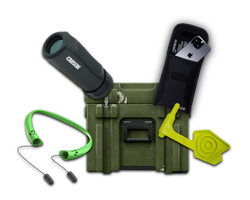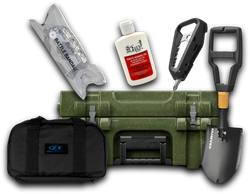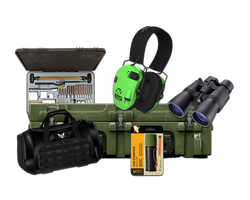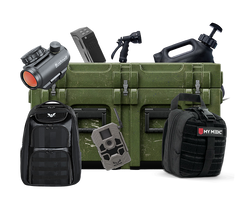How Heavy Should a Backpacking Sleeping Bag Be?
Table of Contents
- Introduction
- The Importance of Weight in Backpacking Sleeping Bags
- Types of Sleeping Bags and Their Weights
- Insulation Materials and Their Impact on Weight
- Temperature Ratings and Their Relevance
- Tips for Selecting the Right Sleeping Bag
- Crate Club's Offerings
- Conclusion
- FAQ
Introduction
Imagine this: after a long day of hiking through rugged terrain, you finally set up camp as the sun dips below the horizon. You unzip your backpacking sleeping bag, ready to sink into a cocoon of warmth and comfort. But then a thought strikes: "How heavy should my backpacking sleeping bag be?" It's an essential question that could make or break your outdoor experience.
Choosing the right sleeping bag weight is crucial for any backpacker, whether you're a seasoned pro or just starting out. The weight of your sleeping bag not only affects how much you can carry but also influences your comfort level while sleeping under the stars. As you navigate the vast wilderness, understanding the ideal weight for your sleeping bag can enhance your overall backpacking experience.
This post aims to delve into the considerations surrounding the weight of backpacking sleeping bags. We’ll explore the different types of sleeping bags, their insulation materials, and how temperature ratings play a role in your choice. By the end, you'll have a comprehensive understanding of how heavy a backpacking sleeping bag should be, helping you make an informed decision on your next outdoor adventure.
In this blog post, we will cover the following topics:
- The importance of weight in backpacking sleeping bags
- Types of sleeping bags and their weights
- Insulation materials and their impact on weight
- Temperature ratings and their relevance
- Tips for selecting the right sleeping bag
- Crate Club's offerings in sleeping bags and gear
The Importance of Weight in Backpacking Sleeping Bags
When planning a backpacking trip, weight is a paramount concern. Every ounce counts, especially when you’re carrying everything on your back over long distances. A heavy sleeping bag can lead to fatigue, making your journey less enjoyable. Conversely, a sleeping bag that is too light may not provide adequate warmth, compromising your comfort and safety.
Why Weight Matters
-
Physical Strain: Carrying a heavy load can lead to muscle fatigue, soreness, and even injury. A lighter sleeping bag means less strain on your body.
-
Pack Space: Bulkier sleeping bags take up more space in your backpack, limiting the amount of gear you can bring. A lightweight, compressible sleeping bag frees up space for other essentials.
-
Energy Efficiency: A lighter pack allows for more efficient hiking. You can maintain a faster pace and conserve energy, leading to a more enjoyable experience.
Balancing Weight and Comfort
While weight is a critical factor, it shouldn't come at the cost of comfort. Sleep is vital for recovery during long hiking days, and a good night's rest in a comfortable sleeping bag can significantly enhance your performance on the trail. Thus, balancing weight with warmth and comfort is essential.
Types of Sleeping Bags and Their Weights
Sleeping bags come in various shapes and designs, each offering different weights and benefits. Understanding these differences can help you choose the right bag for your needs.
1. Mummy Bags
Mummy bags are designed to closely fit the body, which minimizes the amount of air space inside the bag. This design enhances warmth retention and reduces weight.
-
Average Weight: 1.5 to 3.5 pounds.
-
Best For: Cold weather backpacking due to their excellent heat retention.
2. Rectangular Bags
Rectangular sleeping bags offer more room, making them ideal for car camping or casual backpacking where weight isn't as significant.
-
Average Weight: 2 to 5 pounds.
-
Best For: Casual camping, as they provide more space for movement.
3. Semi-Rectangular Bags
These bags combine the benefits of both mummy and rectangular designs, offering some space while still being relatively lightweight.
-
Average Weight: 2 to 4 pounds.
-
Best For: Backpackers looking for a balance between comfort and weight.
4. Quilts
Sleeping quilts are a lightweight alternative to traditional sleeping bags. They lack a bottom layer of fabric, relying on the insulation to keep you warm. Quilts are often used in conjunction with sleeping pads.
-
Average Weight: 1 to 3 pounds.
-
Best For: Minimalist backpackers who prioritize weight savings.
Insulation Materials and Their Impact on Weight
The insulation material used in a sleeping bag significantly affects its weight, warmth, and compressibility. Understanding the differences between insulation types can help you choose the best option for your needs.
1. Down Insulation
Down insulation is derived from the fluffy undercoating of ducks and geese. It is known for its exceptional warmth-to-weight ratio and compressibility.
-
Pros: Lightweight, highly compressible, and offers excellent insulation.
-
Cons: Expensive and loses insulating properties when wet unless treated.
2. Synthetic Insulation
Synthetic insulation materials, such as polyester, are designed to mimic down's insulating properties. They are usually more affordable and perform better when wet.
-
Pros: Affordable, retains warmth when wet, and dries quickly.
-
Cons: Heavier and less compressible than down.
Choosing Between Down and Synthetic
Your choice between down and synthetic insulation depends on your budget, the expected weather conditions, and your personal preferences. If you're backpacking in wet conditions, synthetic insulation may be the better choice. However, for dry, cold conditions, down offers superior warmth and weight savings.
Temperature Ratings and Their Relevance
Temperature ratings are crucial when choosing a sleeping bag, as they indicate the lowest temperature at which the bag will keep you warm. Understanding these ratings can help you select a bag that matches your needs.
EN Rating System
The European Norm (EN) rating system provides a standardized method for testing sleeping bags. This system includes three ratings:
- Lower Limit: The lowest temperature at which a male tester can expect to sleep comfortably.
- Comfort Rating: The temperature at which a female tester can sleep comfortably.
- Extreme Rating: The lowest temperature at which a bag can prevent hypothermia.
Choosing the Right Temperature Rating
When selecting a sleeping bag, consider the climate and conditions you expect to encounter. If you're anticipating cold nights, it's advisable to choose a bag rated for lower temperatures than you expect. Additionally, layering with appropriate clothing and using a quality sleeping pad can enhance your warmth.
Tips for Selecting the Right Sleeping Bag
Choosing the right sleeping bag requires careful consideration of several factors. Here are some tips to help you make an informed decision:
-
Consider Your Trip Duration: For short trips, you might prioritize comfort over weight. For longer hikes, opt for a lighter sleeping bag.
-
Evaluate Your Sleep Preferences: If you tend to feel cold at night, consider a bag with a lower temperature rating or augment your sleep system with extra layers.
-
Test the Bag: If possible, try out the sleeping bag before your trip. Ensure it fits comfortably and provides adequate warmth.
-
Check Packability: Look for a sleeping bag that compresses well and fits easily into your backpack without taking up too much space.
-
Explore Crate Club's Offerings: Crate Club provides a range of curated tactical gear, including high-quality sleeping bags suitable for backpackers of all levels. Check out their Crate Club Subscription Services for exclusive gear delivered monthly.
Crate Club's Offerings
Crate Club prides itself on curating top-notch tactical gear and survival tools. Whether you're a casual camper or an experienced survivalist, they have something for everyone. Their subscription service offers a variety of tactical gear, including sleeping bags that are lightweight, durable, and designed for optimal performance in the field.
Explore Crate Club's Shop
If you're looking for individual items rather than a subscription, check out the Crate Club Shop. Here, you can find a selection of camping gear that meets your specific needs, ensuring you have the best equipment for your adventures.
Conclusion
In summary, how heavy should a backpacking sleeping bag be? The answer lies in balancing weight, comfort, and warmth based on your individual needs and trip specifics. Consider the type of sleeping bag, insulation material, and temperature ratings to make an informed decision that enhances your outdoor experience.
Remember, whether you're a novice or a seasoned backpacker, the right sleeping bag can significantly impact your comfort on the trail. Embrace the journey of finding your perfect sleeping bag, and don't hesitate to explore Crate Club's curated gear to elevate your next adventure.
FAQ
What is the ideal weight for a backpacking sleeping bag?
The ideal weight varies based on personal preference and the type of trip. Generally, aim for a weight between 1.5 to 3.5 pounds for a mummy bag, depending on insulation and temperature ratings.
How do I choose between down and synthetic insulation?
Choose down for lightweight and compact options in dry conditions, while synthetic is better for wet environments and budget-friendly choices.
What temperature rating should I look for?
Select a sleeping bag with a temperature rating lower than the expected temperatures during your trip to ensure adequate warmth.
Can I use a sleeping bag for both backpacking and car camping?
Yes, but consider the weight and packability if you plan to carry it on a backpacking trip. Rectangular bags are more suitable for car camping, while mummy bags are ideal for backpacking.
Where can I find high-quality sleeping bags?
Explore Crate Club's offerings for curated tactical gear, including sleeping bags designed for various conditions and preferences. Check out their Crate Club Shop for individual purchases.
Share this article



